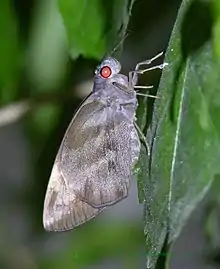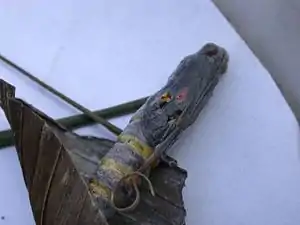Gangara thyrsis
Gangara thyrsis, commonly known as the giant redeye,[1] is a butterfly belonging to the family Hesperiidae. It breeds on a number of palm species.[2][3]
| Giant redeye | |
|---|---|
 | |
| Scientific classification | |
| Kingdom: | |
| Phylum: | |
| Class: | |
| Order: | |
| Family: | |
| Genus: | |
| Species: | G. thyrsis |
| Binomial name | |
| Gangara thyrsis (Fabricius, 1775) | |
Description
The male and female are dark chocolate brown. With a forewing consisting of bright yellow semi-transparent quadrate spots disposed triangularly, the first is large and occupying half the cell, the second also large, obliquely beneath and partly beyond, the third small and obliquely above the second; above the last are three smaller spots obliquely before the apex, the two upper being geminated; in some specimens beneath the subapical spots is a small dot, and on the posterior margin another, both similar to the rest; cilia at posterior angle brownish-white; hindwing with the cilia at the anterior angle brownish white. Underside, forewing irrorated (sprinkled) with grey scales near the apex, posterior margin pale brownish-white, spots yellow as above; hindwing irrorated with grey scales in a series of bands across the wing.[4]

The male of this species presents, on the upperside of each anterior wing, three lines of modified scales, namely, one along the posterior side of the median vein between the origins of its first and second branches, another on each side of the first median veinlet from the origin of this up to the second discal spot, and a third, also double, along an equal portion of the submedian vein, and a thick clothing of setae paler than the groundcolour at the base of the interno-median area, and a similar clothing of paler setae on the middle three-fourths of the sutural area ; and, on the underside, a conspicuous and equally long furry patch of pale fulvous coarse setae divided by the submedian vein.[4]
The wing expanse ranges from 2.5 to 3.25 inches (64 to 83 mm).[4]
Life cycle
The larva is greyish-white with a few ochreous dorsal spots and marks. From the body, a loose shaggy filamentous clothing consisting of pure wax is excreted, but which is easily rubbed off when handled, leaving the larva quite naked.[4]
Food plants
The larvae feed on palms and canes including Cocos nucifera, Calamus pseudotenuis, Calamus rotang, Calamus thwaitesii, Phoenix loureirii, Licuala chinensis and Phoenix humilis.[5] Has also been recorded on Zingiber officinale.[6]
Gallery
 Egg of the giant redeye butterfly
Egg of the giant redeye butterfly Giant redeye caterpillar emerging from its egg
Giant redeye caterpillar emerging from its egg Giant redeye first instar caterpillar
Giant redeye first instar caterpillar Giant redeye second instar caterpillar
Giant redeye second instar caterpillar Caterpillar
Caterpillar Caterpillar
Caterpillar Caterpillar without the wax
Caterpillar without the wax Giant redeye caterpillar in its later instar
Giant redeye caterpillar in its later instar Pupa
Pupa Pupa
Pupa A freshly emerged specimen
A freshly emerged specimen Giant redeye
Giant redeye
References
- R.K., Varshney; Smetacek, Peter (2015). A Synoptic Catalogue of the Butterflies of India. New Delhi: Butterfly Research Centre, Bhimtal & Indinov Publishing, New Delhi. p. 53. doi:10.13140/RG.2.1.3966.2164. ISBN 978-81-929826-4-9.
- W. H., Evans (1949). A Catalogue of the Hesperiidae from Europe, Asia, and Australia in the British Museum. London: British Museum (Natural History). Department of Entomology. pp. 324–325.
-
 One or more of the preceding sentences incorporates text from a work now in the public domain: Swinhoe, Charles (1912–1913). Lepidoptera Indica. Vol. X. London: Lovell Reeve and Co. pp. 161–163.
One or more of the preceding sentences incorporates text from a work now in the public domain: Swinhoe, Charles (1912–1913). Lepidoptera Indica. Vol. X. London: Lovell Reeve and Co. pp. 161–163.
-
 One or more of the preceding sentences incorporates text from a work now in the public domain: E. Y., Watson (1891). Hesperiidae Indicae : being a reprint of descriptions of the Hesperiidae of India, Burma, and Ceylon. Madras: Vest and Company. p. 84.
One or more of the preceding sentences incorporates text from a work now in the public domain: E. Y., Watson (1891). Hesperiidae Indicae : being a reprint of descriptions of the Hesperiidae of India, Burma, and Ceylon. Madras: Vest and Company. p. 84.
- Kunte, K. 2006. Additions to the known larval host plants of Indian butterflies. J. Bombay Nat. Hist. Soc. 103(1):119-121
- Kalesh, S & S K Prakash (2007). "Additions of the larval host plants of butterflies of the Western Ghats, Kerala, Southern India (Rhopalocera, Lepidoptera): Part 1". J. Bombay Nat. Hist. Soc. 104 (2): 235–238.